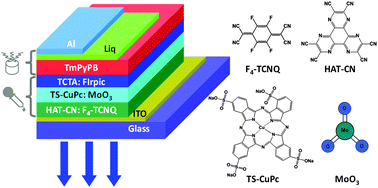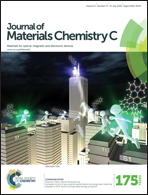Doped hole injection bilayers for solution processable blue phosphorescent organic light-emitting diodes†
Abstract
Carrier injection plays an important role in determining the device performance of organic light-emitting diodes (OLEDs). 1,4,5,8,9,11-Hexaazatriphenylene hexacarbonitrile (HAT-CN) has been widely used as an effective material to promote the hole injection when fabricating vacuum deposited OLEDs. However, serious crystallization occurs in solution-processed HAT-CN films, which weakens its hole injection ability in OLEDs. Herein, we demonstrate a solution-processed composite film as the hole injection layer (HIL) in OLEDs developed by mixing HAT-CN with 2,3,5,6-tetrafluoro-7,7,8,8-tetracyanoquinodimethane (F4-TCNQ). The crystallization is suppressed effectively by optimizing the mixing ratio. In addition, a doping of HAT-CN:F4-TCNQ composite film contributes to a decreased hole injection barrier, which can be reflected from the current density–voltage curve. Furthermore, HAT-CN:F4-TCNQ is successfully combined with MoO3 doped copper phthalocyanine-3,4′,4′′,4′′′-tetra-sulfonated acid tetra sodium salt (TS-CuPc) as bi-HIL in solution-processable blue phosphorescent OLEDs, which exhibit a maximum current efficiency of 16.7 cd A−1.


 Please wait while we load your content...
Please wait while we load your content...